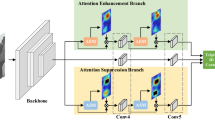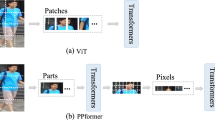Abstract
Person Re-identification (ReID) is a challenging task due to the inherently large intra-class variation and subtle inter-class differences. Early works mainly tackle this problem by learning a discriminative pedestrian feature representation. Recently, vision transformer (ViT) has shown outstanding performance in many tasks, where the self-attention mechanism plays a key role that links every patch tokens with the class token. Intuitively, the class token could serve as a good global feature that captures local details naturally. Experiments demonstrate that the vanilla ViT can achieve impressive performance when directly applied to the ReID problem. Nevertheless, the class token may pay much attention to most salient patches while ignoring less salient but informative ones and missing some potential clues. To reduce this limitation, we propose a novel network MDCTNet to mine divers clues for person re-identification with transformers. Based on the cascaded architecture of transformer encoder, a Patch Suppression Module (PSM) is incorporated into the last several transformer layers, which aims to progressively discard some most salient patch tokens and make less salient ones passed to the next layer. Thus, the model is enforced to mine more potential useful clues in the remained patches and the resulting pedestrian representation can be more robust. Extensive experiments on three mainstream datasets including Market1501, DukeMTMC-ReID and MSMT17 validate the effectiveness of our method.
Access this chapter
Tax calculation will be finalised at checkout
Purchases are for personal use only
Similar content being viewed by others
References
Carion, N., Massa, F., Synnaeve, G., Usunier, N., Kirillov, A., Zagoruyko, S.: End-to-end object detection with transformers. In: Vedaldi, A., Bischof, H., Brox, T., Frahm, J.-M. (eds.) ECCV 2020. LNCS, vol. 12346, pp. 213–229. Springer, Cham (2020). https://doi.org/10.1007/978-3-030-58452-8_13
Chen, B., Deng, W., Hu, J.: Mixed high-order attention network for person re-identification. In: ICCV (2019)
Chen, T., et al.: Abd-net: Attentive but diverse person re-identification. In: ICCV (2019)
Chen, X., et al.: Salience-guided cascaded suppression network for person re-identification. In: CVPR (2020)
Dosovitskiy, A., et al.: An image is worth 16x16 words: Transformers for image recognition at scale. In: International Conference on Learning Representations (2021)
He, S., Luo, H., Wang, P., Wang, F., Li, H., Jiang, W.: Transreid: Transformer-based object re-identification. arXiv preprint arXiv:2102.04378 (2021)
Hermans, A., Beyer, L., Leibe, B.: In defense of the triplet loss for person re-identification. arXiv preprint arXiv:1703.07737 (2017)
Hou, R., Ma, B., Chang, H., Gu, X., Shan, S., Chen, X.: Interaction-and-aggregation network for person re-identification. In: CVPR (2019)
Kalayeh, M.M., Basaran, E., Gökmen, M., Kamasak, M.E., Shah, M.: Human semantic parsing for person re-identification. In: Proceedings of the IEEE Conference on Computer Vision and Pattern Recognition, pp. 1062–1071 (2018)
Li, Z., et al.: Revisiting stereo depth estimation from a sequence-to-sequence perspective with transformers. arXiv preprint arXiv:2011.02910 (2020)
Liu, R., Yuan, Z., Liu, T., Xiong, Z.: End-to-end lane shape prediction with transformers. In: (WACV) (2021)
Miao, J., Wu, Y., Liu, P., Ding, Y., Yang, Y.: Pose-guided feature alignment for occluded person re-identification. In: ICCV (2019)
Qi, L., Huo, J., Wang, L., Shi, Y., Gao, Y.: Maskreid: A mask based deep ranking neural network for person re-identification. arXiv preprint arXiv:1804.03864 (2018)
Ristani, E., Solera, F., Zou, R., Cucchiara, R., Tomasi, C.: Performance measures and a data set for multi-target, multi-camera tracking. In: Hua, G., Jégou, H. (eds.) ECCV 2016. LNCS, vol. 9914, pp. 17–35. Springer, Cham (2016). https://doi.org/10.1007/978-3-319-48881-3_2
Ristani, E., Tomasi, C.: Features for multi-target multi-camera tracking and re-identification. In: CVPR, pp. 6036–6046 (2018)
Song, C., Huang, Y., Ouyang, W., Wang, L.: Mask-guided contrastive attention model for person re-identification. In: Proceedings of the IEEE Conference on Computer Vision and Pattern Recognition, pp. 1179–1188 (2018)
Su, C., Li, J., Zhang, S., Xing, J., Gao, W., Tian, Q.: Pose-driven deep convolutional model for person re-identification. In: ICCV (2017)
Sun, Y., Zheng, L., Deng, W., Wang, S.: Svdnet for pedestrian retrieval. In: ICCV (2017)
Sun, Y., Zheng, L., Yang, Y., Tian, Q., Wang, S.: Beyond part models: Person retrieval with refined part pooling (and a strong convolutional baseline). In: Ferrari, V., Hebert, M., Sminchisescu, C., Weiss, Y. (eds.) ECCV 2018. LNCS, vol. 11208, pp. 501–518. Springer, Cham (2018). https://doi.org/10.1007/978-3-030-01225-0_30
Tay, C.P., Roy, S., Yap, K.H.: Aanet: Attribute attention network for person re-identifications. In: CVPR (2019)
Wang, G., et al.: High-order information matters: Learning relation and topology for occluded person re-identification. In: CVPR (2020)
Wang, G., Yuan, Y., Chen, X., Li, J., Zhou, X.: Learning discriminative features with multiple granularities for person re-identification. In: Proceedings of the 26th ACM international conference on Multimedia (2018)
Wei, L., Zhang, S., Gao, W., Tian, Q.: Person transfer gan to bridge domain gap for person re-identification. In: CVPR (2018)
Xu, J., Zhao, R., Zhu, F., Wang, H., Ouyang, W.: Attention-aware compositional network for person re-identification. In: CVPR (2018)
Zhang, Z., Lan, C., Zeng, W., Jin, X., Chen, Z.: Relation-aware global attention for person re-identification. In: CVPR (2020)
Zhao, H., et al.: Spindle net: Person re-identification with human body region guided feature decomposition and fusion. In: CVPR (2017)
Zheng, F., et al.: Pyramidal person re-identification via multi-loss dynamic training. In: CVPR (2019)
Zheng, L., Huang, Y., Lu, H., Yang, Y.: Pose-invariant embedding for deep person re-identification. IEEE Trans. Image Process. 28, 4500–4509 (2019)
Zheng, L., Shen, L., Tian, L., Wang, S., Wang, J., Tian, Q.: Scalable person re-identification: A benchmark. In: ICCV (2015)
Zheng, S., et al.: Rethinking semantic segmentation from a sequence-to-sequence perspective with transformers. In: CVPR (2021)
Zheng, Z., Zheng, L., Yang, Y.: A discriminatively learned cnn embedding for person reidentification. ACM Trans. Multimedia Comput. Commun. Appli. 14, 1–20 (2018)
Zhou, K., Yang, Y., Cavallaro, A., Xiang, T.: Omni-scale feature learning for person re-identification. In: ICCV (2019)
Zhuang, Z., et al.: Rethinking the distribution gap of person re-identification with camera-based batch normalization. In: Vedaldi, A., Bischof, H., Brox, T., Frahm, J.-M. (eds.) ECCV 2020. LNCS, vol. 12357, pp. 140–157. Springer, Cham (2020). https://doi.org/10.1007/978-3-030-58610-2_9
Author information
Authors and Affiliations
Corresponding author
Editor information
Editors and Affiliations
Rights and permissions
Copyright information
© 2022 The Author(s), under exclusive license to Springer Nature Switzerland AG
About this paper
Cite this paper
Song, X., Feng, J., Du, T., Zhang, H. (2022). Mining Diverse Clues with Transformers for Person Re-identification. In: Yu, S., et al. Pattern Recognition and Computer Vision. PRCV 2022. Lecture Notes in Computer Science, vol 13536. Springer, Cham. https://doi.org/10.1007/978-3-031-18913-5_44
Download citation
DOI: https://doi.org/10.1007/978-3-031-18913-5_44
Published:
Publisher Name: Springer, Cham
Print ISBN: 978-3-031-18912-8
Online ISBN: 978-3-031-18913-5
eBook Packages: Computer ScienceComputer Science (R0)




